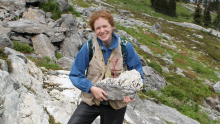Increasing levels of ocean acidity could spell doom for British Columbia's already beleaguered northern abalone, according to the first study to provide direct experimental evidence that changing sea water chemistry is negatively affecting an endangered species.
The northern abalone--prized as a gourmet delicacy--has a range that extents along the North American west coast from Baja California to Alaska. Even though British Columbia’s northern abalone commercial fisheries where closed in 1990 to protect dwindling populations, the species has continued to struggle, largely due to poaching.
To better understand the impact climate change — and specifically, increasing ocean acidity — has on this endangered species, UBC researchers exposed northern abalone larvae to water containing increased levels of CO2. Increases from 400 to 1,800 parts per million killed 40 per cent of larvae, decreased the size of larvae that did survive, and increased the rate of shell abnormalities.
"This is quite bad news, not only in terms of the endangered populations of abalone in the wild, but also the impact it might have on the prospects for aquaculture and coastal economics," says Christopher Harley, Associate Professor with the Department of Zoology and one of the authors of the study.
"And because the species is already thought to be limited by reproductive output and recruitment, these effects are likely to scale up to the population level, creating greater limits on population growth."
Average CO2 levels in the open ocean hover at 380 parts per million, a number which is excepted to increase slowly over the next century.
What concerns the researchers are the much higher spikes in dissolved CO2 that are already being observed along the BC coast, particularly in late spring and early summer when northern abalone populations are spawning.
The findings were published in the latest issue of the Journal of Experimental Marine Biology and Ecology.
"While we’re looking at a single species that is culturally important as a source of food and artistic inspiration for many coastal Pacific Northwest First Nations, this information may have implications for other abalone species in other parts of the world," says Ryan Crim, lead author on the paper who conducted the research while a graduate student with the UBC Department of Zoology.
Other species of abalone are farmed around the world, principally in China, Taiwan, Japan and Korea. The black, white and pink abalone are also endangered on the west coast--red abalone are still an economically viable food species.
The study was funded by the Natural Sciences and Engineering Research Council of Canada and conducted in collaboration with the Bamfield-Huu-ay-aht Community Abalone Project, a small abalone hatchery in Bamfield which has subsequently gone out of business. The dual mission of the hatchery was to produce cultured abalone for high end restaurants, and to restore endangered abalone by culturing and releasing larvae and juveniles to the wild.
Harley and Crim will continue to work with the aquaculture industry to study the effects of acidification on oysters and other shellfish.
Journal of Experimental Marine Biology and Ecology
www.sciencedirect.com/science/article/pii/S0022098111000499
Musqueam First Nation land acknowledegement
We honour xwməθkwəy̓ əm (Musqueam) on whose ancestral, unceded territory UBC Vancouver is situated. UBC Science is committed to building meaningful relationships with Indigenous peoples so we can advance Reconciliation and ensure traditional ways of knowing enrich our teaching and research.
Learn more: Musqueam First Nation
Faculty of Science
Office of the Dean, Earth Sciences Building2178–2207 Main Mall
Vancouver, BC Canada
V6T 1Z4


